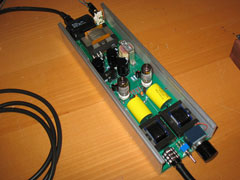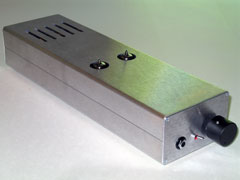www.beezar.com

Less-Pressivo Origins
Several years ago, Dsavitsk posted a new take on a design by Gary Dahl - the Espressivo headphone amplifier. The Espressivo headphone amplifer by Gary Dahl used a parafeed amplifier circuit with top-of-the-line, expensive components. Dsavitsk was interested in building this type of amp design, but with low-cost components (see advantages of the parafeed design in Gary Dahl's article and in the Tech Highlights page on this website). The result was his version of the "L'espressivo (Less-Pressivo)." Interestingly, Dsavitsk obtained great results with his own take on the design and components that totaled little more than $100. The result was an astounding success! Several of us in the DIY community were very interested in this design (me especially!) because of the low cost and simple construction. Additionally, Dsavitsk documented the design and building techniques quite extensively at his DIY website. His work now includes over 3 different versions, including his top-of-the-line commercial offering, the L-2 headphone Amplifier - available through ECP Audio. |
 
|
| User cetoole, the designer of the MAX/MiniMAX/MOSFET-MAX, built one to his own specifications and used it to power everything from Sennheisers to orthodynamics. cetoole L'es  
|
|
| For me personally, I was still chicken to mess with high-voltage point-to-point construction. So I reluctantly stayed away from the L'espressivo for awhile. During this time, Dsavitsk designed a PCB-version of Pete Millett's Starving Student Millett Hybrid. He and I teamed up to provide almost 200 Starving Student PCB kits to the DIY headphone community. Unfortunately, the worldwide supply for 19J6 tubes was severely limited. Our Starving Student PCB kits stopped when the 19J6 tubes were no longer available. While Dsavitsk was searching for a replacement design, I suggested to him my wish for a PCB-version of the Less-Pressivo. It might be that even someone like me - afraid of high-voltage construction - could safely build one.
Dsavitsk took the challenge and set about designing the Less-Pressivo PCB amplifier. He followed the basic principles of parafeed tube amplifier design with his own design touches and an interest in economical construction (as in his own Less-Pressivo). In a brilliant move, he came up with a Less-Pressivo PCB design that was based on a tube from the same family as the 19J6 tubes of the Starving Student: the 6J6. This was particulary satisfying because of the responses I received when attempting to find more 19J6 tubes for the Starving Student. Almost without fail, every tube vendor contacted about 19J6 tube availability would ask, "Can't you use the 6J6 instead? We've got thousands of them!" The going rate for these tubes was $2 each and sometimes lower, if purchased in volume. |
|
Less-Pressivo PCB Prototypes -
Dsavitsk first constructed a "board" version of the Less-Pressivo PCB to test the fundamentals of the circuit - transformer design, CCS and bias techniques for the 6J6 tubes, etc.: Based on his findings, he determined that some distance was needed to keep from magnetic coupling the output transformers with the power transformer. For awhile, two-piece configurations of the PCB were explored, but I was convinced that we needed a single PCB - after all, messing about with high-voltage wiring was the whole thing we were trying to prevent. This led to a unusual PCB configuration: long and thin. It gave the design the adequate distance between power transformer and output transformers. A couple of 13" long PCBs were manufactured for us and the custom transformers ordered. Hammond Mfg was contacted to see if they could produce a special long-extrusion based on one of their 4-inch wide 1455-series cases. With the necessary components acquired, Dsavistk and I each built a prototype: The Less-Pressivo PCB amp was displayed at CanJam '10 in Chicago. A lot of interest was shown. It was felt that some more tweaking may have been needed and because the design was such a radical departure from existing designs, Dsavitsk felt that more prototyping would help. We solicited a half-dozen builders to build their versions of the Less-Pressivo PCB: Knowledgeable builders all, they provided even more extensive testing than Dsavitsk and I could. Dsavitsk tweaked the bias setting recommendations and eventually decided on a new transistor-controlled bias. Distortion and dynamics improved. Heat was still a problem, though, and despite the length of the design, more room was needed to fit a larger heat sink for the heater supply, transistor bias parts, and new heat sinks for the CCS transistors. Meanwhile, several nicknames were bandied about by the builders and the people who saw the amp - "sausage," "cruiser," and "torpedo." After awhile, so many people started referring to it as the "Torpedo," the name stuck. |
|
TORPEDO! Prototypes -
Dsavitsk made a final PCB design and switched to the Context case. The Context case was a bit wider than the Hammond and also taller. With both case types, the tubes are slightly above the case lid, but neither offers enough tube exposure to allow pulling a tube out of its socket. With the Hammond, almost complete disassembly was required to change the tubes. The Context case is a true two-piece design, with the top and bottom halves of the case separated along the middle and locked together by the end plates. That means by removing the top screws on the the front plate and back plate, the entire top half of the case can be removed, facilitating tube rolling. Two more prototype PCB's were ordered. These PCB's contained the onboard design for the transistor biasing, onboard heat sinks for the CCS transistors, and a new regulator for the heater supply. The new PCB was 14 inches long, instead of the earlier 13 inches - firmly establishing its reputation as a Torpedo! Forum user Digger945 and myself built these two last prototypes: After successfully testing these final prototypes, I made some last-minute case design changes, removing cooling slots from the bottom (they had no affect when covered up) and adding some cooling slots on top. The cooling was slightly enhanced with these changes and the additional slots allowed all of the LED lighting to shine through (sorry, I'm a sucker for LED lights). The production models were next! |
|
file last changed:Monday, May 27, 2024 12:25:39 PM
Please contact the TORPEDO webmaster for questions about these web pages.












